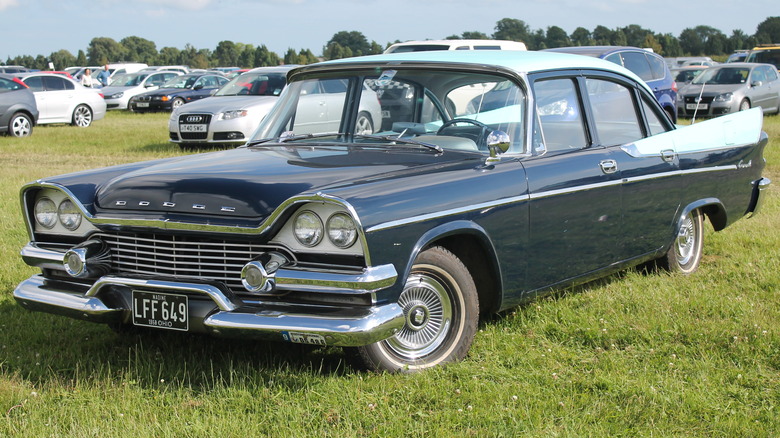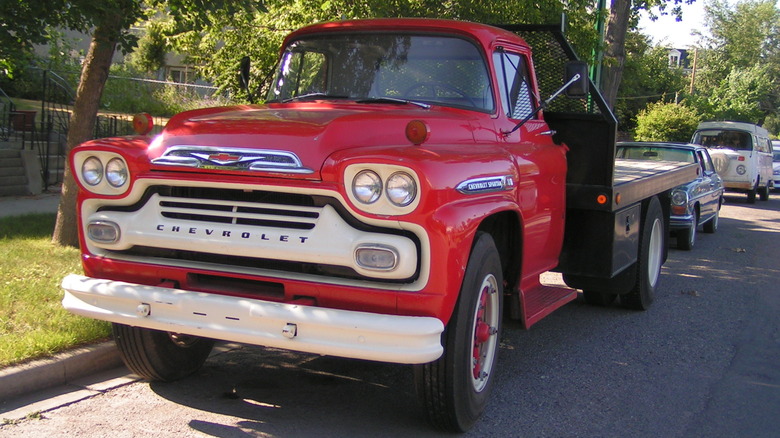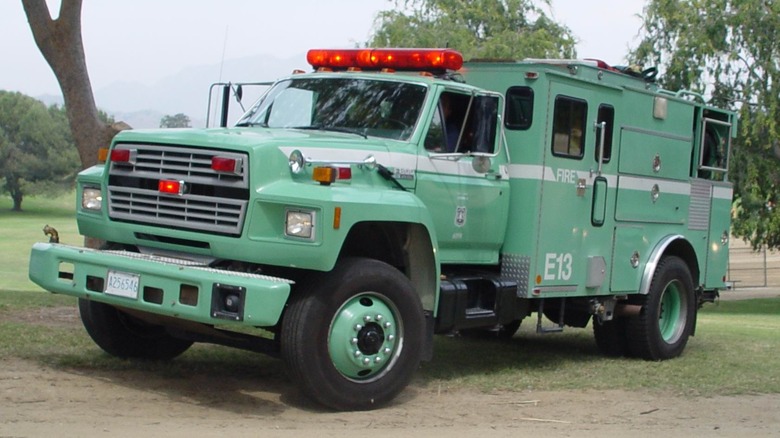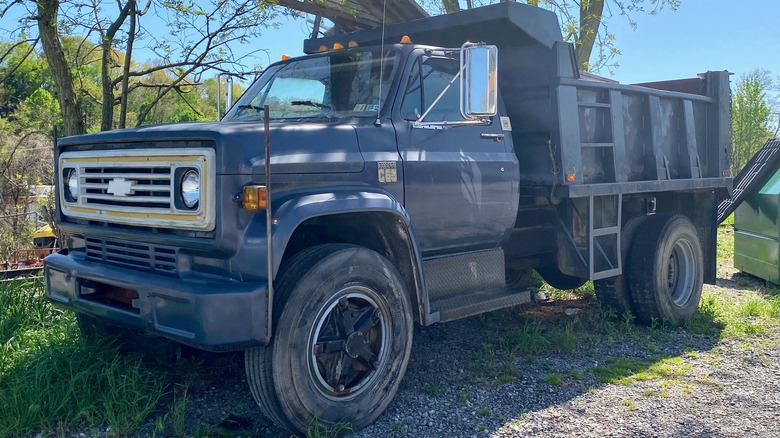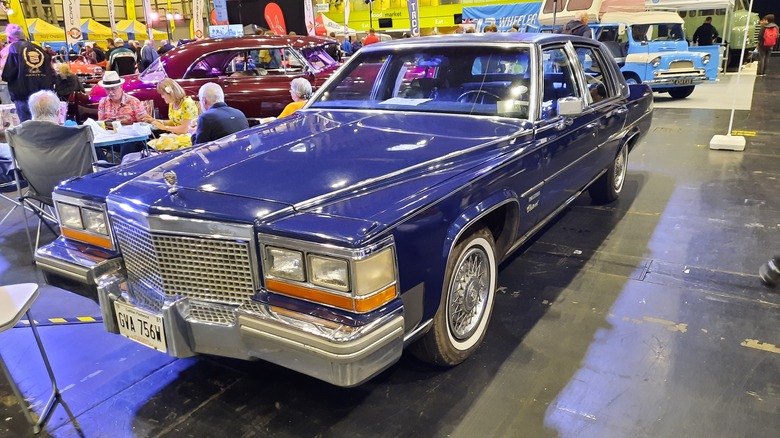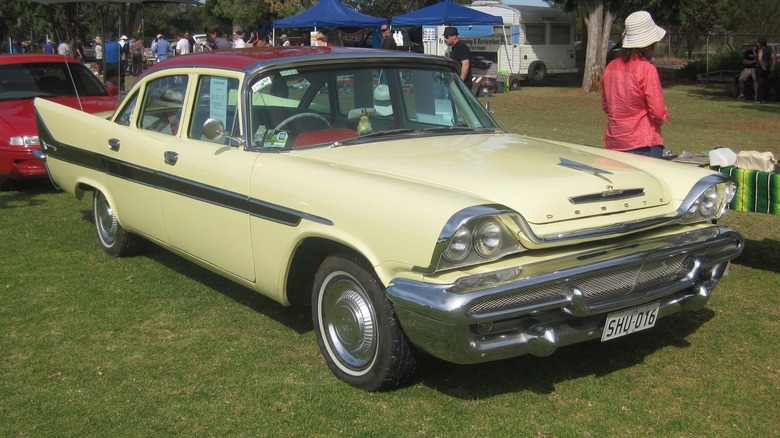5 Of The Smallest Big-Block Engines Ever Built
There are many ways that automakers, particularly American ones, categorize the V8 engines they produce. They can essentially be put into one of two categories: big-block engines and small-block engines. The difference between them seems like it would be easy to spot. It's right there in the name, right? Big-block engines have a bigger engine displacements, while small-block engines have smaller displacements. It's not that simple, however, because there is little to no uniformity to how companies actually classify them. Even within the ranks of one specific company, two engines that have the same displacement could be labeled as different types of blocks. What really separates the two is the actual build size of the engines rather than the volume created by the bore and stroke, though the two are obviously tied together most of the time.
Because there is no definitive cutoff point between big-block and small-block engines, that can lead to there being big-block engines that actually seem somewhat small in comparison to the wider landscape of big-blocks. This phenomenon is not specific to one particular company but can be seen throughout the industry. Here, we are going to spotlight five different big-block V8 engines that are relatively smaller in size than you might expect from an engine that bears that distinction. This list may seem to have a heavy focus on American-made engines, but considering that companies like General Motors loom so large over V8 engine history, that trend is basically unavoidable.
[Featured image by Charlie via Wikimedia Commons | Cropped and scaled | CC BY 2.0]
1958 Chevrolet 348 V8
Almost no automaker out there is more synonymous with big-block engines than Chevrolet. Just use Google to search the phrase "big-block engines," and you will immediately be inundated with articles, wikis, forums, and sellers all centered around Chevrolet big-blocks to the point that you might think it is the only company to ever produce them. That isn't the case, but Chevrolet does need significant representation here. There is no better place to start than with the company's very first big-block V8, all the way back in 1958.
Chevrolet had been making plenty of small-block V8 engines prior to this, but with the addition of larger size pickup trucks coming into the company's lineup, it needed something more powerful to properly run those vehicles. Therefore, the first big-block was born, called the 348. As the name suggests, this was a V8 with a displacement of 348 cubic inches — or 5.7L for a more modern designation — thanks to a 4.125 in. bore and 3.25 in. stroke. Although this was used in some Chevrolet cars, its most useful application was for trucks, and the company used it in those pickups through 1964, three years longer than in its cars.
In terms of power output, the Chevy 348 could generate 250 hp and 355 lb-ft of torque. That was already a pretty good amount at a base level, but "Super Turbo Thrust" models were also offered that increased the horsepower to 280 thanks to three two-barrel carburetors. As the years progressed, variations on the 348 would steadily increase that power, and it would peak in 1961 with a model that generated 350 hp and 364 lb-ft of torque.
[Featured image by dave_7 via Wikimedia Commons | Cropped and scaled | CC BY-SA 2.0]
1977 Ford 370 V8
With engines like the Chevrolet 348, they are big-block engines intended to be impressive powerhouses on somewhat smaller vehicles. Yes, it was used in plenty of pickup trucks, but in the wide range of vehicle sizes, those are still relatively small. Sometimes these big-block engines are used to power vehicles that require a tremendous amount of power for tasks like hauling heavy loads, and that is exactly what Ford used its 370 engine for starting in the late 1970s.
This V8 is part of Ford's 385 series of big-block engines. The 429 and 460 models are what this series was built on starting in 1968, and they powered some of the company's most popular vehicles. However, there is still the 370 model, which was introduced nearly a decade into the series' existence to fill a pretty specific function. 1977 was when Ford decided to ditch the medium-block FE 360 engine for large commercial vehicles like the F-600/700 and C-600/700. This is an engine made to power large dump trucks, buses, and firetrucks, all of which are built on large body frames.
The Ford 370, which was quickly rebranded as a 6.1L V8 as automakers moved away from cubic inch measurements, would be phased out of all of the vehicles it was used for by the end of the 1980s to be replaced by a variety of different engines. Sometimes Ford would look to other engines, and most of the time it would utilize diesel-powered engines instead. The need for the Ford 370 was no more.
[Featured image by Firelookout via Wikimedia Commons | Cropped and scaled | Attribution]
1966 Chevrolet 366 V8
Ford was not the only company to use these smaller big-block V8 engines for its larger commercial vehicles and heavier duty trucks, and it wasn't the first automaker to do it, either. The company was beaten to the punch on that by over a decade by — as you might expect — Chevrolet. As mentioned previously, big-block V8s and Chevrolet go together like peanut butter and jelly, so it makes sense that it was utilizing a surprisingly small big-block in these larger vehicles going all the way back to 1966.
The Chevrolet 366 V8 made its debut in the Chevy C80, L80, M80, and T80 models that year. All of these vehicles are the largest variations of the heavy-duty trucks that the company made. For example, the L stood for "Low-Cab Forward" and the T for "Tilt Cab." They were also available as an option for the 60 models too, and the following year, the 366 became standard for those as well. Initially, the V8 was able to deliver 185 net hp and 315 net lb-ft of torque, but as the years passed, these numbers steadily increased.
Even though this big-block engine goes all the way back to the 1960s, Chevrolet kept the 366 V8 in rotation all the way through 1990, after which the company revamped its big-block engine lineup entirely. It may not have been the most versatile engine that Chevrolet ever produced, but any engine that remains in production for over 20 years clearly was able to fill a need satisfactorily.
[Featured image by Cutlass via Wikimedia Commons | Cropped and scaled | CC0 1.0]
1980 Cadillac 368 V8
One might assume that the larger your engine displacement is, the bigger the vehicle you need to be driving. However, you can have a big-block V8 underneath the hood of a sedan, a coupés, and more. The big-blocks mentioned so far have been in large vehicles, but even larger engines from the same engine families powered vehicles much smaller. That being said, these smaller big-block V8s could also be far more versatile than simply being in large trucks if given the opportunity, and that is where the Cadillac 368 V8 comes in to play.
This engine, given the production code L61, was introduced in 1980, and rather than be utilized in commercial and work vehicles, it was instead designated more for luxurious vehicles like the Cadillac DeVille, the Fleetwood Brougham, and the company's limousines. With 6.0L of displacement and a four-barrel carburetor, it had an output of 150 hp and 265 lb-ft of torque. That may not seem like it is a powerhouse, but considering this coming after the 1970s that saw major restrictions on emissions, an oil crisis, and a change in how horsepower ratings were calculated, those are actually pretty decent numbers, particularly for vehicles that place priority on luxury over performance.
One year later, Cadillac would drop the L61 from its lineup in favor of the L62, which would be standard for every Cadillac except the Seville, to try and improve fuel economy even more. However, the L62 ended up being something of a disaster, as its technological desires greatly overstepped its actual abilities that led to a myriad of problems.
[Featured image by Kieran White via Wikimedia Commons | Cropped and scaled | CC BY 2.0]
1958 Chrysler 350 V8
The final entry on this list takes us away from the likes of General Motors and Ford and takes us to Stellantis with the brand that was once one of the true juggernauts in the American auto space, Chrysler. Like the previously mentioned small big-block V8 from Cadillac, this particular Chrysler engine also only lasted for essentially one year of production. That engine would be the Chrysler 350 V8, which hit the market in 1958.
For V8 engines, Chrysler had been using its FirePower engines — which would later be known as its Hemi line — and the company decided to rethink how it produced these engines. This is where it introduced the Chrysler B and RB wedge engines as a replacement, and the first two the company produced were the 350 and the 361. The smaller of them features 5.7L of engine displacement and could be found in a few different models as an upgraded option, though none of them were actually Chrysler branded vehicles.
Plymouth utilized it for the 1958 Plymouth Fury and gave it the nickname of the Golden Commando engine. Dodge put the Chrysler 350 inside both the Royal and Sierra models for the year. Lastly, there was the DeSoto Firesweep, a car that had been introduced just one year previously. Depending on which model the Chrysler 350 V8 was in, it would be able to generate anywhere from 280 to 315 hp and 370 to 380 lb-ft of torque.
In 1959, Chrysler introduced the 383 big-block V8, and the 361 model became the smaller option, meaning that the 350 V8 was no longer needed.
[Featured image by GTHO via Wikimedia Commons | Cropped and scaled | CC BY-SA 4.0]
